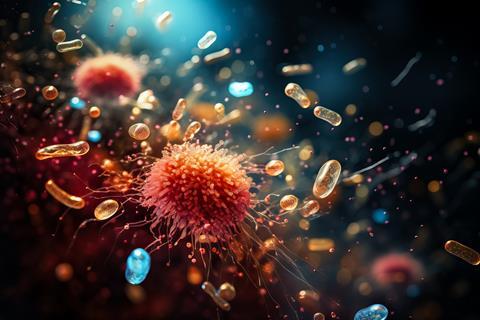In the gut, dozens of strains of bacteria exert different effects on the immune system that in turn impact our health – fending off pathogens, helping digest food and maybe even influencing behavior. But pinpointing which bacteria exert which effects has been challenging.

Better understanding this process could lead to a powerful way to treat a host of diseases.
For developing a method by which to zero in on individual gut bacterium’s impacts on T cells, Kazuki Nagashima, a senior research scientist at Stanford University, is the winner of this year’s NOSTER & Science Microbiome Prize, which rewards innovative research by young investigators working on attributes of the microbiota with potential to guide therapeutic interventions.
Multiple bacteria
Nagashima’s work showed that – contrary to what has been thought – some T cells in the gut can interact with multiple bacteria.
“This discovery presents a therapeutic opportunity to skew gut immune reaction [in therapeutically useful ways],” said Nagashima in his prize-winning essay.
“For the NOSTER/Science Prize, 2024 has been a truly blockbuster year in more ways than one,” said Caroline Ashle, senior editor at Science. “It is heartening to see such high quality science from a new generation of extremely motivated young scientists, who succeed in doing fantastic research despite today’s huge challenges.”
READ MORE: Microbiome molecule may hamper immune cells’ cancer-fighting abilities
READ MORE: Gut bacteria can change their ‘software’ in reaction to inflammation
Nagashima’s prize-winning work, published in Nature in 2023, followed earlier efforts to build a synthetic human gut microbiome from scratch. “Typically, the human gut microbiome cannot be reproduced because it has so many strains,” he said. But he and colleagues achieved this feat, building a model composed of the most common taxa from the human gut microbiota. It combined 119 species of bacteria.
Synthetic microbiome
When the researchers gave the synthetic microbiome to mice that did not have a microbiome of their own, the bacterial strains took hold and remained stable – even when the scientists introduced other microbes.
But the question of how gut T cells interact with a full gut microbiome – all the different bacterial species – remained open.
So after helping to build the synthetic microbiome, Nagashima joined colleagues in the lab of Stanford’s Michael Fischbach who wanted to look at how use the model to characterize the gut’s response to this massive bacterial community.
They followed a careful process, looking for signatures of T cell receptor (TCR) stimulation to individual bacteria. The thinking to date was that a TCR should recognize and be stimulated by a specific bacterium.
Evaluating responses
To explore this further, Nagashima and his colleagues evaluated the responses of T cells from mice to each bacterial member of the synthetic gut microbiome. “We cocultured T cells with each strain in the bacterial community—one at a time,” he explained.
They did this for hundreds of strains of bacteria as represented in the synthetic gut – looking at individual T cell responses.
“This method is so much more efficient than what has been done to test the function of bacterial strains,” said Nagashima. “Now we can tell which bacteria induce T cells in the context of hundreds of strains. There has previously been no way to do this.”
Intriguing pattern
Looking at T cell responses to each of the strains, however, they observed something intriguing. Contrary to what was expected, some T cells were stimulated by multiple bacterial strains.
“The result was inconsistent with the hypothesis that a TCR is specific to one strain in the community,” said Nagashima. “Instead, this result suggests that one T cell can recognize multiple bacterial strains simultaneously.”
Nagashima dubbed these T cells “blockbuster” T cells. Further study revealed they respond to many bacteria because they recognize a part of the bacteria’s surface – an antigen – that looks similar across different bacterial strains.
Therapeutic implications
The understanding of the power of these particular T cells, as they interact with the gut, holds therapeutic implications, including for improving cancer therapies involving CAR T cells.
It could also help scientists working to add or delete specific bacterial strains to achieve specific health effects.
“This year marks the fifth year of the prize, and I am thrilled to see our young scientists once again passionately pursuing research on microbiome-based therapeutics to enhance human health,” said Kohey Kitao, CEO of NOSTER Inc. “I am excited to witness how the prize continues to drive scientific discoveries aimed at preventing and treating numerous chronic diseases worldwide.”
Prize finalists
Lina Yao, a scientist at Genentech, is a finalist for the NOSTER & Science Microbiome Prize. In her essay, “Bacteria act as architects of host T cell modulators using bile acids,” she talks about her work to manipulate certain bacterial pathways to offer novel therapeutic approaches for treating inflammatory bowel disease and other autoimmune disorders.
Brittany Needham is a finalist for the NOSTER & Science Microbiome Prize for her essay, “A microbial metabolite influences myelination in the brain.” Her research elucidated insights into how bacterial metabolites impact the brain – specifically myelin, an insulating layer on neuronal axons. These results will provide chemical targets to therapeutically influence the brain via the gut.







No comments yet